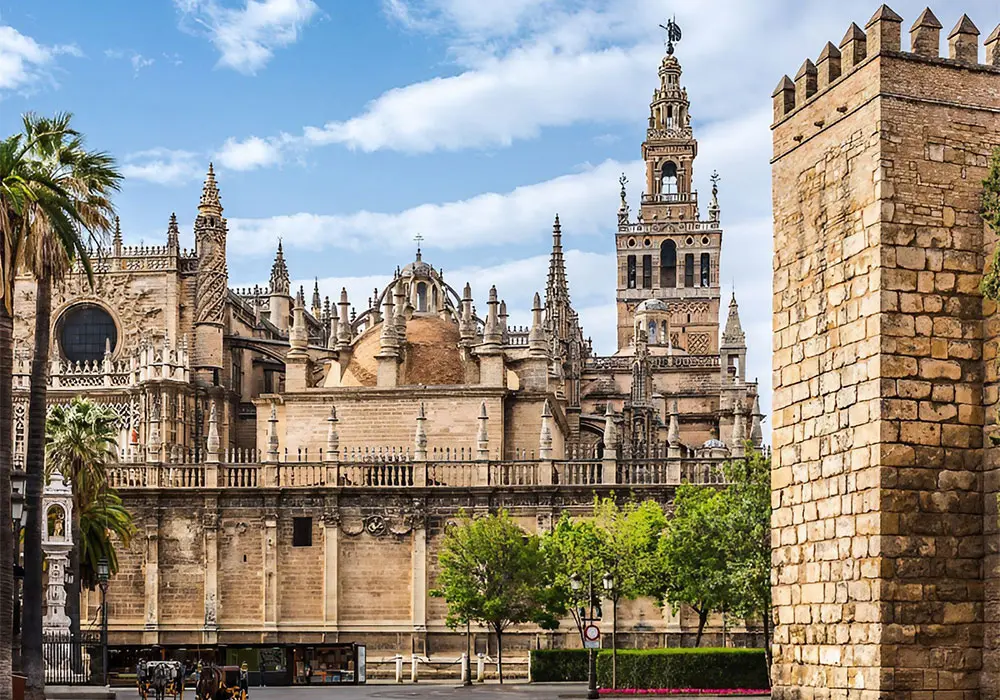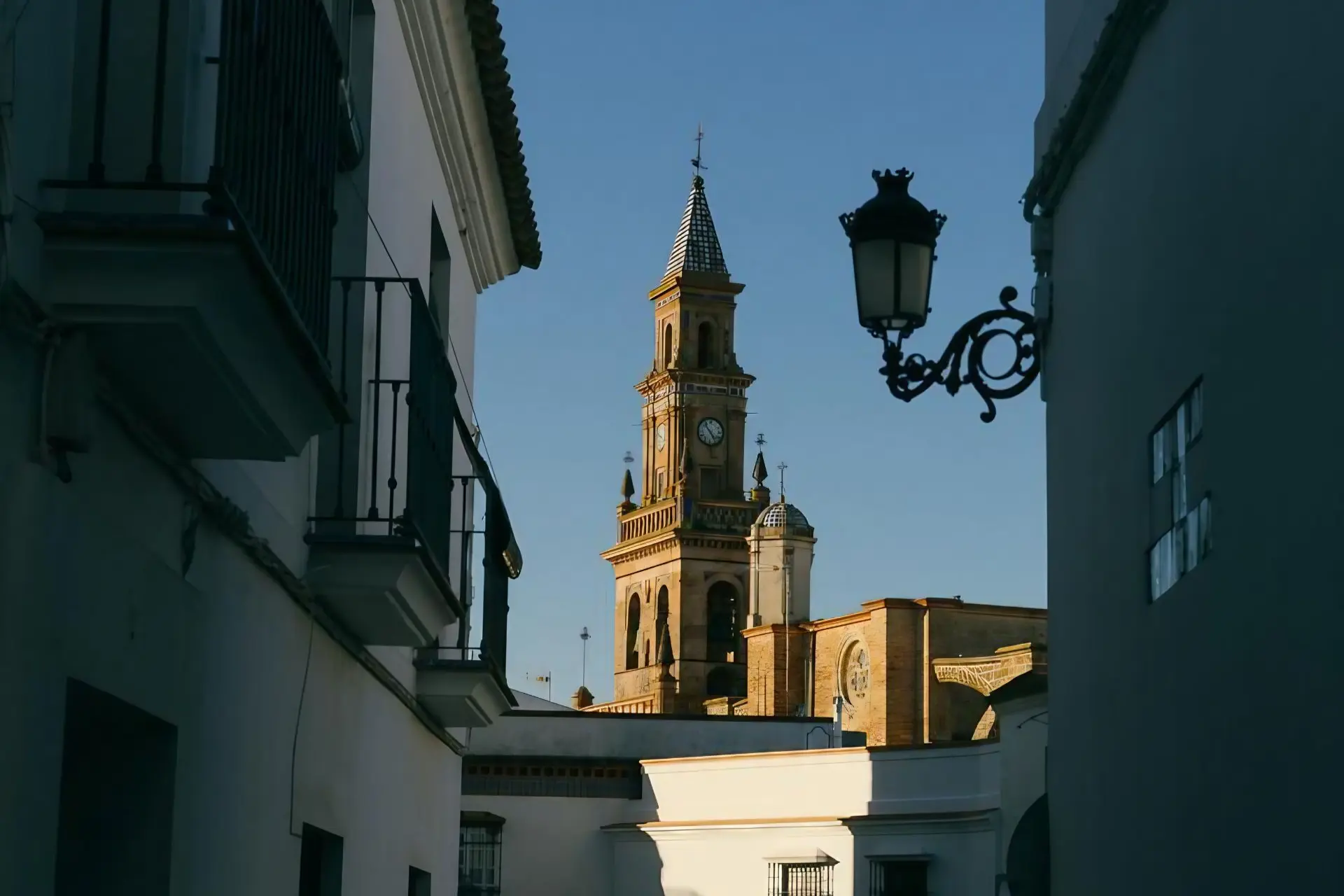
Andalucía, the southernmost region of Spain, is renowned for its rich history, vibrant culture, and stunning architecture. Each of its provinces—Cadiz, Huelva, Seville, Granada, Cordoba, Malaga, Jaen, and Almeria—has a cathedral that stands as a testament to the region’s diverse influences and artistic heritage.
Cathedral of Cadiz
The Cathedral of Cadiz, officially known as the Cathedral of the Holy Cross, is a stunning example of Spanish Baroque and Neoclassical architecture. Construction began in 1722 and was completed in 1838, taking over a century to finish due to interruptions caused by economic difficulties.

One of the cathedral’s most striking features is its golden dome, which gleams under the Andalusian sun. The interior is equally impressive, with a mix of Baroque and Neoclassical elements. The crypt is particularly noteworthy, as it houses the tomb of the famous Spanish composer Manuel de Falla.
The cathedral is home to numerous artworks, including a remarkable collection of paintings and sculptures. The altarpiece in the main chapel is a masterpiece of gilded wood, and the choir stalls are intricately carved.
Cathedral of Huelva
The Cathedral of Our Lady of Mercy in Huelva is a relatively modest structure compared to some of its Andalusian counterparts. Originally built in the 17th century as a Jesuit church, it was designated a cathedral in 1954.

The cathedral showcases a mix of Baroque and Renaissance styles. Its façade is simple yet elegant, with a central bell tower that adds to its charm. The interior is adorned with beautiful altarpieces and religious icons.
The cathedral’s main attraction is the statue of Our Lady of Mercy, a revered figure in Huelva. The annual procession of this statue is a significant event in the local religious calendar.
Cathedral of Seville
Seville Cathedral, officially known as the Cathedral of Saint Mary of the See, is the largest Gothic cathedral in the world. Construction began in 1401 on the site of a former mosque, with the cathedral being completed in 1507.

The cathedral’s Giralda tower, originally a minaret, is an iconic symbol of Seville. The vast interior includes the largest altarpiece in Christendom, an intricately carved Gothic masterpiece. The cathedral also houses the tomb of Christopher Columbus, adding to its historical significance.
Seville Cathedral is rich in art, including works by Murillo, Goya, and Zurbarán. The Retablo Mayor, a grand altarpiece depicting scenes from the life of Christ, is a highlight of the cathedral’s artistic treasures.
Cathedral of Granada
The Cathedral of Granada, officially the Cathedral of the Incarnation, was built on the site of a former mosque. Construction began in 1518 and continued for nearly two centuries, resulting in a blend of Gothic, Renaissance, and Baroque styles.

The main façade, designed by Alonso Cano, is a splendid example of Spanish Baroque architecture. Inside, the cathedral features a grandiose nave and several chapels adorned with intricate altarpieces and religious art.
One of the most significant artworks is the statue of the Virgin of the Anguishes, the patron saint of Granada. The Royal Chapel adjoining the cathedral is the burial site of the Catholic Monarchs, Ferdinand and Isabella, who played pivotal roles in the history of Spain.
Cathedral of Cordoba
The Cathedral of Our Lady of the Assumption, more commonly known as the Mosque-Cathedral of Cordoba, is a unique blend of Islamic and Christian architecture. Originally built as a mosque in the 8th century, it was converted into a cathedral in the 13th century.

The forest of columns and horseshoe arches within the Mezquita is an architectural marvel. The Renaissance nave inserted into the heart of the mosque is a striking contrast to the Islamic design. The bell tower, once a minaret, offers panoramic views of the city.
The mihrab, or prayer niche, is a masterpiece of Islamic art, while the Baroque altarpiece in the main chapel is a significant Christian addition. The cathedral also houses a remarkable collection of religious artifacts and artworks.
Cathedral of Malaga
The Cathedral of Malaga, officially the Cathedral of the Incarnation, was built between 1528 and 1782. Its Renaissance-style architecture is notable, although it remains unfinished, with one of its planned towers missing, earning it the nickname “La Manquita” (The One-Armed Lady).

The interior has grand columns and an impressive altarpiece. The choir stalls, carved by Luis Ortiz, are a highlight, featuring intricate woodwork depicting various saints and biblical scenes.
The cathedral also has numerous artworks, including paintings by Alonso Cano and sculptures by Pedro de Mena. The Chapel of the Incarnation, with its beautiful frescoes and statues, is particularly noteworthy.
Cathedral of Jaen
The Cathedral of the Assumption of the Virgin in Jaen is a Renaissance masterpiece. Construction began in 1249, but the current structure was primarily built between the 16th and 18th centuries.

The façade, designed by Andrés de Vandelvira, is a stunning example of Spanish Renaissance architecture. The interior features a vast nave with elegant columns and a richly decorated altar.
The cathedral houses the Holy Veil, a revered relic believed to bear the imprint of Christ’s face. The choir stalls, crafted by Pedro de Mena, are another artistic highlight, showcasing exquisite woodwork.
Cathedral of Almeria
The Cathedral of Almeria, officially the Cathedral of the Incarnation, was built between 1524 and 1562. Its fortress-like appearance is due to its dual function as a place of worship and a defensive structure against pirate attacks.

The cathedral’s Gothic and Renaissance styles are evident in its design. The robust exterior contrasts with the elegant interior, which features a beautiful altarpiece and numerous chapels.
The sacristy houses a collection of valuable religious artifacts, including an impressive silver processional cross. The tomb of Bishop Diego Fernández de Villalán, a significant figure in the cathedral’s history, is located within the building.
The cathedrals of Andalucía are not just places of worship; they are repositories of history, art, and culture. Each cathedral reflects the unique heritage of its province, showcasing a blend of architectural styles and housing an array of artistic treasures.
From the grandeur of Seville Cathedral to the unique Mosque-Cathedral of Cordoba, these structures offer a fascinating glimpse into Andalucía’s past.
























